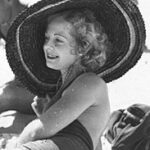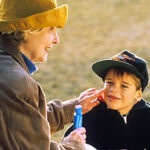

Whenever you’re in the sun, remember the mantra above: SLIP on a shirt – SLOP on sunscreen – SLAP on a hat, and – WRAP your eyes in sunglasses. After that, go have fun!
Why did we ever think tanning was good?
In 1923, fashion icon Coco Chanel vacationed on a yacht near Cannes. When she returned to shore, Coco glowed with sun-kissed skin. Almost immediately, fashionable people flocked to southern France to lay in the sun. During the 1920s, people didn’t know much about sun damaged skin, though as years passed there was growing awareness that light-skinned people with dark tans also developed wrinkled, leathery skin.
Though I cringe to think of it, when I was a teen-ager, my friends and I basted ourselves with cocoa butter and spent summer days sizzling in the sun. The result: tan skin, sun-kissed hair, and the beginning my present battle against seborrheic keratosis, an itchy, ugly but thankfully non-cancerous skin growth. Did I mention it itches?
The High Cost of Tanning
Skin cancer cases in the United States rise every year. Out of every five people, one develops skin cancer. There are two types of skin cancer. Basal cell skin cancer is the most common with about 3.6 million cases diagnosed every year. Basel cell cancers grow slowly and are the easiest to treat and cure.
Squamous cell skin cancer is far more serious. About 1.6 million cases are diagnosed annually. It grows rapidly and can metastasize if not detected and treated in its early stages.
Avoid Skin Cancer by Taking Precautions in the Sun
The sun shines on everyone, whether they lie on a beach, swing a golf club, or mow the lawn. If the sun is out, we all need to take precautions.
The sun’s rays are strongest between 10:00 in the morning, and 2:00 in the afternoon. Try to avoid direct exposure during those hours. And during all sunny hours, stay in the shade as much as possible.


Sun protective clothing is now available in the form of light weight, long-sleeved shirts; and long pants. Clothing should be labeled with an ultraviolet protection factor (UPF) label. Wear a broad brimmed hat, particularly one with ultraviolet protection.
Wear sunglasses with UV protection. The label should read UV400 or 100% UV protections. These provide the most protection from UV rays. Wrap-around glasses provide more protection.

And WEAR SUNSCREEN. Wear it everywhere including the back of the neck, the tops of the feet, the back of the knees, the ears, and the top of the head. I once had a sunburn where my hair parted. Ouch! Should have been wearing a hat. If skin is exposed, slap on sunscreen. Most adults need enough sunscreen to fill a shot glass to cover their entire body. And don’t forget, it takes 15 minutes for skin to absorb sunscreen.

Be sure to protect young children. Plopping them under an umbrella isn’t enough. They need the same protection as adults.
What type of sunscreen offers the most protection without harming coral reefs?
Broad Spectrum Sunscreens protect the skin from both Ultraviolet A Rays (UVA) and Ultraviolet B Rays (UVB), and they should be water resistant with an SPF rating of SPF 30 or higher. Be sure to select MINERAL-BASED SUNSCREEN. These contain zinc oxide and/or titanium dioxide, deflect the sun’s rays away from the skin, and when they wash off in the lake or ocean, they won’t harm coral reefs or other sea life.

u Bay, Big Island of HawaiiGlobally, up to 6,000 tons of sunscreen wash into ocean reefs and other popular bodies of water. Mineral-based sunscreens won’t harm coral reefs.
Chemical sunscreens are highly toxic to juvenile corals and contribute to coral bleaching. Sunscreens containing oxybenzone and octinoxate are banned in the State of Hawai`i. Some sunscreens proclaim they are “reef safe,” but there is no regulatory body. When in doubt, read the ingredients on the label.

Coral reefs need clear water and sunlight to survive. Coral reefs support more marine species than any other habitat. Chemical sunscreens are killing coral reefs. The reef at Kahalu`u Bay on the Big Island of Hawai`i is suffering. On the island of Maui, several coral reefs lost 25 percent of their living coral populations between 1994 and 2006. In this photo, coral bleaching is visible in comparison to healthy colorful coral.
Protect yourself and coral habitat around the world by only wearing mineral-based sunscreen. Good Housekeeping recommends nine zinc oxide sunscreens for face and body which are listed below.
Dr Niraj Lal explains how sunscreen works and offers good reminders for fun in the sun in his quintessential Australian accent.
Good Housekeeping list of zinc oxide sunscreens : Sunforgettable Total Protection Body Shield SPF50; Coppertone Pure & Simple SPFG 50 Sunscreen; Eryfotona Acinica Sunscreen SPF 50+; Bare Republic Mineral Face Sunscreen Lotion SPF 30; Sun Bum Mineral SPF 30 Non-tinted Sunscreen Face Lotion; MD Solar Sciences Mineral Moisture Defense Sunscreen SPF 50; Bare Republic Mineral Gel Face Sunscreen Lotion SPF 30; Australian Gold Botanical SPF 50 Mineral Lotion, and for children Neutrogena Pure & Free Baby Sunscreen SPF 50.
Amina Lake Avdelrahman & Birnur Aral. ” Best Zinc Oxide Sunscreens of 2021.” Good Housekeeping. June 17, 2021
Basal Cell Carcinoma Overview. Skin Cancer Foundation.
Julia Calderone. “The Truth About Reef Safe Sunscreen.” Consumer Reports. April 29, 2021.
😎 😎 😎
Illustrations
Slip-Slap-Slop-Wrap
Coppertone
Woman in sun hat on Bondi Beach
Sun glasses by Susanne Nilson
Applying Sunscreen. National Cancer Institute.
Sun Safety for Infants
Snorkelers with sea turtle at Kahaluu Bay by Vlad & Marina Butsky
Coral Reef Bleaching b y Jay Galvin

Sandra Wagner-Wright holds the doctoral degree in history and taught women’s and global history at the University of Hawai`i. Sandra travels for her research, most recently to Salem, Massachusetts, the setting of her new Salem Stories series. She also enjoys traveling for new experiences. Recent trips include Antarctica and a river cruise on the Rhine from Amsterdam to Basel.
Sandra particularly likes writing about strong women who make a difference. She lives in Hilo, Hawai`i with her family and writes a blog relating to history, travel, and the idiosyncrasies of life.

